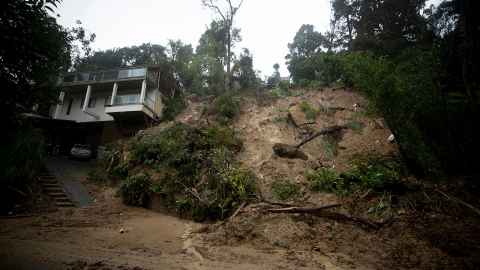Life in the red-stickered zone needn’t be quite this hard
13 March 2023
Opinion: Muriwai resident, Associate Professor Vivienne Elizabeth, shares her experience in the profoundly disempowering state of limbo of a red-stickered area.

My first home was perched 3-4m from a bank that sloped away another 3-4m to a rough paddock below. Any time a gale lashed the house, I would have nightmares of waking to discover the house was remorselessly sliding down the hill.
Paradoxically, while the sounds of storms lashing my Muriwai home have kept me awake, they’ve never prompted the same nightmares. Yet anxieties about the stability of cliffs 150-200m from our home prompted the late morning call on Friday, February 17, for almost everyone on our street to urgently evacuate on foot.
For those who had been evacuated on the night of Monday, February 14, during the height of Cyclone Gabrielle’s torrential rain and gale-force winds, to a building without power or a generator, Friday’s repeat performance must have been a re-traumatising and logistical nightmare. Most of the homes of people subject to Friday’s evacuation order have been subsequently red-stickered by Auckland Council.
What being red-stickered means, though, is complicated and confusing. There are at least three types of red-stickered homes in Muriwai. The first consists of the small number of houses destroyed by collapsing cliff faces or suffering damage from a landslide. The second type comprises undamaged homes that seem obviously at risk of damage or destruction because of their proximity to the cliffs or a recent slip. The third type is made up of intact homes that appear, at least to the untrained eye, to be at little risk of being swept up in a landslide. Our home is of this type.
It’s highly likely that residents of different types of red-stickered houses have distinct perceptions about the risks of reoccupying their homes.
Red-stickered residents do not know, for example, when and under what conditions they might retrieve possessions and their household effects, let alone whether they might ever resume occupancy of their homes. While it’s important to acknowledge the efforts council staff are making to meet community members, meetings are held as in-person events even though residents are now dispersed across Auckland and beyond. Many have wondered why not use the internet-based communication technologies we became so proficient at using through Covid-19 lockdowns. At least recordings of meetings are posted on YouTube, which is one thing for which to be grateful.
But there have been many things residents are not happy about, and could be managed better. Update meetings are structured as council talking sessions; council staff have made little effort to find out residents’ questions within the meeting, only individually afterwards. No wonder some community members interject while council staff are talking. If the council used more participatory processes, it would likely lead to a more productive relationship between council staff and the community.
The protocol the council is devising to enable residents to retrieve “portable property” will grant two fit household members 20 minutes of gathering time before they must leave on foot. These retrieval missions are to be supervised by a geotech engineer and council compliance officer. Presumably, the latter condition is to prevent people from attempting to move large household items. However, it is just as likely to add insult to already injured residents, causing them to feel angry over further disempowerment.
Some of these missteps are belatedly being corrected by council staff. However, many could have been avoided by ‘working with’ rather than ‘working for’ the Muriwai community, and not assuming ‘we’ know best.
We don’t know what we don’t know, including what we don’t know about how other people live. If we have worked for all our lives in an office, we mightn’t think about the implications of our decisions for the ‘tradie’ whose tools are locked out of reach in a garage. Similarly, we might think about the challenges mothers and fathers face on a daily basis when children of all ages don’t have their clothes, toys and games.
If we have worked for all our lives in an office, we mightn’t think about the implications of our decisions for the ‘tradie’ whose tools are locked out of reach in a garage.
To work with human beings takes a degree of humility, a willingness to recognise that whatever expertise you’ve cultivated isn’t enough and that members of the communities suffering from disasters hold important insights and knowledge that are worth hearing and taking on board. Working in partnership with affected communities and sharing the science behind decisions is vital.
Fortunately, Muriwai, like other west coast villages of Auckland, has ‘rep’: it is a community with a track history of networking, organising, and achieving community-related goals.
It fundraises, organises events, improves the local environment and, as the aftermath of Cyclone Gabrielle has shown, helps each other out. It’s hardly surprising, therefore, that this community has come together over the past few weeks to share information and to disperse the all-important necessities of life, like food, pots and pans, and clothes. For many of us, that community spirit has been the saving grace of these disastrous times.
Associate Professor Vivienne Elizabeth is a sociologist and gender studies scholar, and a resident of Muriwai.
This article reflects the opinion of the author and not necessarily the views of Waipapa Taumata Rau University of Auckland.
This article was first published on Newsroom, Life in the red-stickered zone needn’t be quite this hard, 11 March, 2023.
Media contact
Margo White I Research communications editor
Mob 021 926 408
Email margo.white@auckland.ac.nz